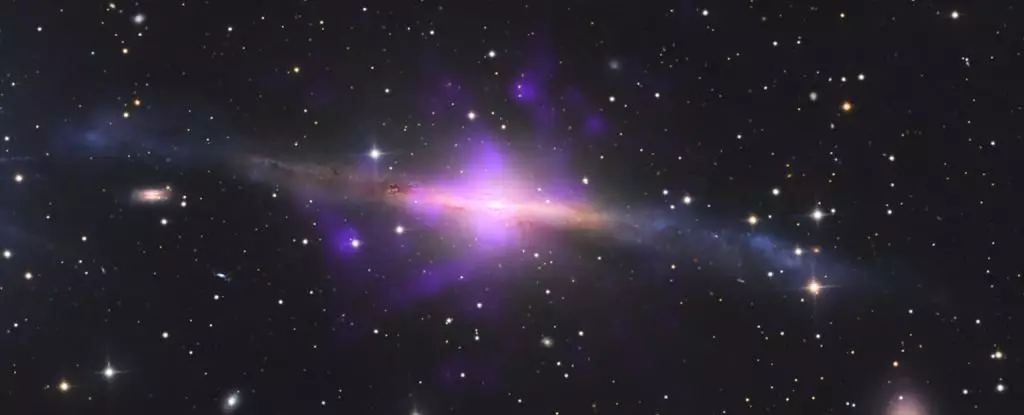Astronomers have long marveled at the enormity and complexity of galaxies, but recent discoveries about the galaxy NGC 5084 have unearthed a mystery that challenges our understanding of supermassive black holes. Located approximately 80 million light-years from Earth, this lenticular galaxy is not just another point in the cosmos; it holds peculiar secrets that researchers are now attempting to unravel. At the heart of NGC 5084 lies a supermassive black hole that has displayed unexpected behavior—its rotational axis is tilted, essentially lying on its side, thus resembling an otherworldly “Uranus of black holes.”
Discovered by the esteemed William Herschel in 1785, NGC 5084 is categorized as a lenticular galaxy—a cosmic formation that straddles the line between the defined structures of spiral and elliptical galaxies. Unlike galaxies with prominent spiral arms, NGC 5084 presents a more nebulous form, characterized by a vast disk stretching over 200,000 light-years and an estimated mass equivalent to 1.3 trillion solar masses. While this extensive research includes centuries of observations, our understanding of its central black hole remains limited, primarily due to the challenges posed by its edge-on orientation and the bright dust obscuring the galactic center.
The fundamental question arises: how did the central black hole of NGC 5084 become tilted? This compelling inquiry reverberates through the scientific community, prompting astronomers to scrutinize archival data in search of clues.
Led by astronomer Alejandro Borlaff from NASA Ames Research Center, the research team utilized innovative image analysis techniques to dig deeper into past observations from NASA’s Chandra X-ray Observatory. The breakthrough came unexpectedly when scientists identified four extraordinary plumes of X-ray-emitting plasma arrayed in an X formation, pointing towards a highly active past of the galactic center. These jets serve as astronomic signatures of complex interactions between the supermassive black hole and surrounding materials.
When a black hole consumes matter from its vicinity, not all of it vanishes beyond the event horizon. Instead, some of this material is redirected along magnetic field lines towards the black hole’s poles, resulting in the formation of these powerful jets. Initially, they discovered two plumes extending as predicted within the galactic plane; however, the other pair intermingled with the galactic disk, signaling a transformative shift—an indication that the black hole was originally situated in a typical position but may have undergone a radical reorientation.
Intrigued by this revelation, Borlaff and his team plunged further into archival archives, incorporating data from various observatories, including the Hubble Space Telescope, the Atacama Large Millimeter/submillimeter Array, and the Expanded Very Large Array radio telescope, alongside new observations from the Apache Point Observatory. Borlaff’s metaphor of piecing together a cosmic crime scene underscores the collaborative effort required to decipher this phenomenon.
The culmination of their extensive investigations affirmed the existence of the jets while also clarifying their origin. In scrutinizing the core of the galaxy, researchers identified a dust band aligned contrary to the galactic plane—an unprecedented observation suggesting that this supermassive black hole is indeed oriented on its side. This anomaly may signify a cataclysmic event, such as a merger with another galaxy housing a supermassive black hole, resulting in a collision that caused the dramatic tilt.
Furthermore, the team was able to ascertain the mass of the black hole for the first time, calculated at an astonishing 45.7 million times that of the Sun. Such findings are pivotal for future studies regarding the mechanics of black holes and the dynamics that govern their movements and reactions within galactic frameworks.
The findings surrounding NGC 5084 not only demonstrate the potential for utilizing archival astronomical data to retrieve historical cosmic events, but they also steer the narrative away from conventional wisdom about supermassive black holes. As astrophysicist Pamela Marcum noted, the detection of two pairs of X-ray plumes heralds exceptional discoveries that shatter preconceived notions about cosmic behavior in seemingly stable environments.
While NGC 5084 has been scrutinized for centuries, modern astrophysical techniques have unveiled that our perceptions of galaxies can shift dramatically with new evidence. The tilted black hole raises questions about the nature of such entities and their development within their galactic homes. As research continues, scientists are poised to unravel more enigmas that the universe harbors, ensuring that the cosmos remains a thrilling domain for discovery, exploration, and understanding.

